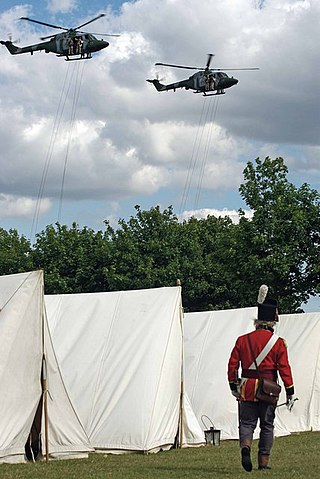Related Research Articles
Military strategy is a set of ideas implemented by military organizations to pursue desired strategic goals. Derived from the Greek word strategos, the term strategy, when first used during the 18th century, was seen in its narrow sense as the "art of the general", or "the art of arrangement" of troops. and deals with the planning and conduct of campaigns, the movement and disposition of forces, and the deception of the enemy.

Trench warfare is a type of land warfare using occupied lines largely comprising military trenches, in which combatants are well-protected from the enemy's small arms fire and are substantially sheltered from artillery. It became archetypically associated with World War I (1914–1918), when the Race to the Sea rapidly expanded trench use on the Western Front starting in September 1914.

Aerial warfare is the use of military aircraft and other flying machines in warfare. Aerial warfare includes bombers attacking enemy installations or a concentration of enemy troops or strategic targets; fighter aircraft battling for control of airspace; attack aircraft engaging in close air support against ground targets; naval aviation flying against sea and nearby land targets; gliders, helicopters and other aircraft to carry airborne forces such as paratroopers; aerial refueling tankers to extend operation time or range; and military transport aircraft to move cargo and personnel.
A revolution in military affairs (RMA) is a hypothesis in military theory about the future of warfare, often connected to technological and organizational recommendations for military reform.
AirLand Battle was the overall conceptual framework that formed the basis of the US Army's European warfighting doctrine from 1982 into the late 1990s. AirLand Battle emphasized close coordination between land forces acting as an aggressively maneuvering defense, and air forces attacking rear-echelon forces feeding those front line enemy forces. AirLand Battle replaced 1976's "Active Defense" doctrine, and was itself replaced by "Full Spectrum Operations" in 2001.

Maneuver warfare, or manoeuvre warfare, is a military strategy which emphasizes movement, initiative and surprise to achieve a position of advantage. Maneuver seeks to inflict losses indirectly by envelopment, encirclement and disruption, while minimizing the need to engage in frontal combat. In contrast to attrition warfare where strength tends to be applied against strength, maneuver warfare attempts to apply strength against weakness in order to accomplish the mission.

Modern warfare is warfare that diverges notably from previous military concepts, methods, and technology, emphasizing how combatants must modernize to preserve their battle worthiness. As such, it is an evolving subject, seen differently in different times and places. In its narrowest sense, it is merely a synonym for contemporary warfare.
Network-centric warfare, also called network-centric operations or net-centric warfare, is a military doctrine or theory of war that aims to translate an information advantage, enabled partly by information technology, into a competitive advantage through the computer networking of dispersed forces. It was pioneered by the United States Department of Defense in the 1990s.
Principles of war are rules and guidelines that represent truths in the practice of war and military operations.
In military science, force multiplication or a force multiplier is a factor or a combination of factors that gives personnel or weapons the ability to accomplish greater feats than without it. The expected size increase required to have the same effectiveness without that advantage is the multiplication factor. For example, if a technology like GPS enables a force to accomplish the same results as a force five times as large without GPS, then the multiplier is five. Such estimates are used to justify the investment for force multipliers.

Industrial warfare is a period in the history of warfare ranging roughly from the early 19th century and the start of the Industrial Revolution to the beginning of the Atomic Age, which saw the rise of nation-states, capable of creating and equipping large armies, navies, and air forces, through the process of industrialization.

Tunnel warfare is using tunnels and other underground cavities in war. It often includes the construction of underground facilities in order to attack or defend, and the use of existing natural caves and artificial underground facilities for military purposes. Tunnels can be used to undermine fortifications and slip into enemy territory for a surprise attack, while it can strengthen a defense by creating the possibility of ambush, counterattack and the ability to transfer troops from one portion of the battleground to another unseen and protected. Also, tunnels can serve as shelter from enemy attack.

Anti-surface warfare is the branch of naval warfare concerned with the suppression of surface combatants. More generally, it is any weapons, sensors, or operations intended to attack or limit the effectiveness of an adversary's surface ships. Before the adoption of the submarine and naval aviation, all naval warfare consisted of anti-surface warfare. The distinct concept of an anti-surface warfare capability emerged after World War II, and literature on the subject as a distinct discipline is inherently dominated by the dynamics of the Cold War.
Battlespace or battle-space is a term used to signify a military strategy which integrates multiple armed forces for the military theatre of operations, including air, information, land, sea, cyber and outer space to achieve military goals. It includes the environment, timeframe and other factors, and conditions that must be understood to successfully apply combat power, protect the force, or complete the mission. This includes enemy and friendly armed forces, infrastructure, weather, terrain, and the electromagnetic spectrum within the operational areas and areas of interest.
Effects-based operations (EBO) is a United States military concept that emerged during the Persian Gulf War for the planning and conduct of operations combining military and non-military methods to achieve a particular effect. An effects-based approach to operations was first applied in modern times in the design and execution of the Desert Storm air campaign of 1991. The principal author of the daily attack plans—then Lt Colonel, now retired Lt General David A. Deptula—used an effects-based approach in building the actual Desert Storm air campaign targeting plan. Deptula describes the background, rationale, and provides an example of how an effects-based approach to targeting was conducted in Desert Storm in the publication, "Effects-Based Operations: Change in the Nature of Warfare." The doctrine was developed with an aim of putting desired strategic effects first and then planning from the desired strategic objective back to the possible tactical level actions that could be taken to achieve the desired effect. Contrary to conventional military approaches of force-on-force application that focused on attrition and annihilation, EBO focused on desired outcomes attempting to use a minimum of force. The approach was enabled by advancements in weaponry—particularly stealth and precision weapons—in conjunction with a planning approach based on specific effects rather than absolute destruction. Deptula, speaking at the Gulf War Air Campaign Tenth Anniversary Retrospective, on 17 January 2001 on One Massachusetts Avenue, NW, Washington, DC, defined the goal of EBO; "If we focus on effects, the end of strategy, rather than force-on-force the traditional means to achieve it militarily, that enables us to consider different and perhaps more effective ways to accomplish the same goal quicker than in the past, with fewer resources and most importantly with fewer casualties." Others have postulated that EBO could be interpreted as an emerging understanding that attacking a second-order target may have first order consequences for a variety of objectives, wherein the Commander's intent can be satisfied with a minimum of collateral damage or risk to his own forces.
Intelligence dissemination management is a maxim of intelligence arguing that intelligence agencies advise policymakers instead of shaping policy. Due to the necessity of quick decision-making in periods of crisis, intelligence analysts may suggest possible actions, including a prediction of the consequences of each decision. Intelligence consumers and providers still struggle with the balance of what drives information flow. Dissemination is the part of the intelligence cycle that delivers products to consumers, and intelligence dissemination management refers to the process that encompasses organizing the dissemination of the finished intelligence.
Swarming is a battlefield tactic designed to maximize target saturation, and thereby overwhelm or saturate the defences of the principal target or objective. Defenders can overcome attempts at swarming by launching counter-swarming measures that are designed to neutralize or otherwise repel such attacks.

In military history, the term "generations of warfare" refers to the concept of five "generations" in warfare, with each generation having different tactics, strategies, and technologies. The generations of warfare are sometimes dubbed as "4GW" or "5GW". The term originated in 1989 to describe "the changing face of war" over time, initially only referring to the emergence of the fourth generation, but eventually seeing the addition of a fifth generation.

The concept of networked swarming warfare was first proposed by HUO Dajun in 2003. The key feature of the Information Age is the networking of organizational structure. The rising networked organization will overcome the limitation of traditional geography and link the operational resources distributed widely to form a military action network which combine strike range, speed and lethality, three elements of originally different developing, fundamentally transforming our idea of battle space. With the trend of decentralization of forces, we need to develop more small units with independent combat functions; meanwhile we can join these small units into a whole network as the technology's development. The warfare based on this network is called networked swarming warfare.
References
- ↑ Boot, M. 2003. ‘‘The New American Way of War.’’ Foreign Affairs